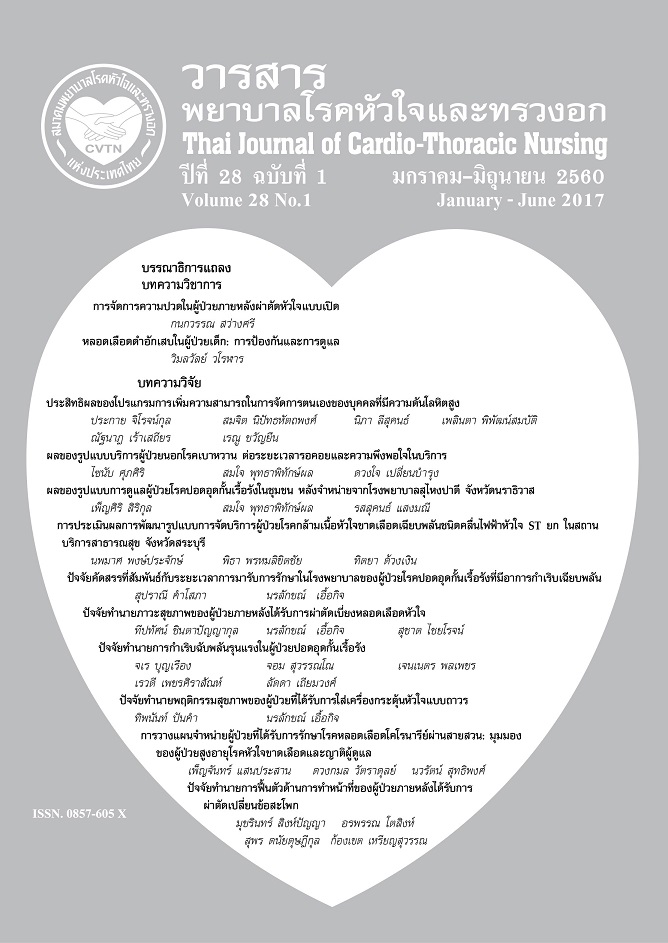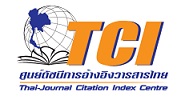ปัจจัยทำนายการกำเริบฉับพลันรุนแรงในผู้ป่วยปอดอุดกั้นเรื้อรัง
Keywords:
ปอดอุดกั้นเรื้อรัง, การกำเริบฉับพลันรุนแรง, รูปแบบทำนายปัจจัยเสี่ยง, chronic obstructive pulmonary disease, severe acute exacerbations, risk predictive modelAbstract
การวิจัยแบบติดตามไปข้างหน้า 3 เดือนนี้ ศึกษาโมเดลอิทธิพลของปัจจัย 3 กลุ่ม ด้านบุคคล โรคและความเจ็บป่วย และสุขภาวะในการทำนายการกำเริบฉับพลันรุนแรงในผู้ป่วยปอดอุดกั้นเรื้อรัง (COPD) กลุ่มตัวอย่าง 110 ราย จากคลินิกโรคปอดอุดกั้นเรื้อรังโรงพยาบาลชุมชน 3 แห่ง ตัวแปรทำนายมี 13 ปัจจัย ตามกรอบแนวคิดอาการและการจัดการอาการ กลุ่มปัจจัยลักษณะส่วนบุคคลมี 5 ตัวแปร ได้แก่ อายุ เพศ การศึกษา รายได้ การสูบบุหรี่ กลุ่มปัจจัยโรคและความเจ็บป่วย มี 6 ตัวแปร ได้แก่ ดัชนีมวลกาย ระดับความรุนแรงของโรคตาม GOLD Stage ระดับอาการหายใจลำบากประเมินจาก mMRC-DS ประวัติการกำเริบฉับพลันรุนแรงในระยะ 1 ปี ความเหมาะสมของการรักษาพยาบาลในระยะสงบ และปอดอักเสบติดเชื้อ และกลุ่มปัจจัยสุขภาวะมี 2 ตัวแปร ได้แก่ คุณภาพชีวิต ประเมินจาก COPD Assessment Test (CAT) และภาวะซึมเศร้า ประเมินจากแบบคัดกรองภาวะซึมเศร้าของมหาวิทยาลัยขอนแก่น ประเมินผลลัพธ์การเกิดกำเริบฉับพลันรุนแรง จากทะเบียนประวัติการเข้ารับการรักษาที่แผนกอุบัติเหตุฉุกเฉินและหรือการเข้ารับการรักษาในโรงพยาบาลด้วยอาการกำเริบฉับพลันรุนแรง วิเคราะห์ข้อมูลโมเดลปัจจัยเดี่ยวใช้ค่า odds ratio (OR), 95% confidential interval (95%CI), Chi-square และ Fisher exact tests และในโมเดลพหุปัจจัยใช้การถดถอยโลจิสติก
ผลการวิจัย พบว่า โมเดลปัจจัยเดี่ยวมี 6 ตัวแปรที่สัมพันธ์กับการกำเริบฉับพลันรุนแรง เป็นปัจจัยด้านโรคและความเจ็บป่วย 4 ตัวแปร ได้แก่ ระดับความรุนแรงของโรค (p=0.002) ระดับความรุนแรงของอาการหายใจลำบาก (p=0.041) ประวัติการกำเริบฉับพลับรุนแรงในระยะ 1 ปี (OR 40, 95%CI 12.89-124.09, p=0.000) และภาวะปอดอักเสบติดเชื้อ (OR 411.78, 95%CI 23.58-7190.23, p=0.000) ปัจจัยสุขภาวะมี 2 ตัวแปรที่มีทำนาย คือ คุณภาพชีวิตต่ำ (OR 6.42, 95%CI 2.58-15.99, p=0.000) และคะแนนภาวะซึมเศร้าที่เพิ่มขึ้นทุกหนึ่งคะแนน (OR 1.37, 95CI 1.16-1.63, p=0.000) สำหรับปัจจัยด้านบุคคลไม่มีตัวแปรใดทำนาย การวิเคราะห์ในโมเดลพหุปัจจัยพบว่ามีเพียง 2 ตัวแปรคือ ภาวะปอดอักเสบติดเชื้อ และประวัติการกำเริบฉับพลันรุนแรงในระยะ 1 ปี ที่มีค่านัยสำคัญทางสถิติในการทำนายการกำเริบฉับพลันรุนแรง โดยร่วมกันทำนายได้ร้อยละ 74.8 ทั้งนี้ปอดอักเสบติดเชื้อมีค่าสัดส่วนอัตราเสี่ยงในการทำนายสูงสุด (OR 65.26, 95%CI 7.43-527.94, Wald 14.21, p=0.000) และรองลงมาคือประวัติการกำเริบฉับพลันรุนแรงในระยะ1 ปี (OR 8.09, 95%CI 2.09-31.34, Wald 9.14, p=0.003)
การศึกษานี้ให้ข้อมูลเชิงประจักษ์ในการสร้างแนวทางปฏิบัติในการลดการกำเริบฉับพลันรุนแรงในผู้ป่วย COPD โดยป้องกันภาวะปอดอักเสบติดเชื้อ คัดกรองภาวะซึมเศร้า ฟื้นฟูสมรรถภาพปอด และการส่งเสริมคุณภาพชีวิต
Predictors of chronic obstructive pulmonary disease severe acute exacerbation
This prospective study was aimed at exploration whether three set of predictors which included personal, disease and illness, and health status domains could truly predict severe acute exacerbations (AE). One hundred and ten patients with stable COPD, recruited from COPD clinics of three rural hospitals, were followed up for a period of 3 months. A total of 13 variables were based-on the Model of Symptom Management. There were five variables of personal domain including age, gender, education, household income, and smoking status; seven variables of disease and illness domain including body mass index, GOLD staging of COPD severity, mMRC severity of dyspnea, an accuracy of COPD treatment, history of severe AE during the past year, and community acquired pneumonia (CAP); and two variables of health status domain including quality of life, and depression. The COPD disease-specific, health-related quality of life was measured by using the COPD Assessment Test (CAT), and depression was measured by using the Khon Khan University Depression Index (KKU-DI). The main outcome was the occurrence of severe AE as defined by the index of emergency department visits or hospital admissions for COPD during the 3-month follow-up. The univariate model test employed odds ratio (OR), 95% confidential interval (95%CI), Chi-square and Fisher exact tests, and logistic Wald test for the final predictive model.
Results: Univariate test revealed a total of 6 independent predictors of severe AE. These factors included four health and illness factors, severity of COPD (p=0.002), severity of dyspnea (p=0.041), history of severe acute exacerbation (OR 40, 95%CI 12.89-124.09, p=0.000), and CAP (OR 411.78, 95%CI 23.58-7190.23, p=0.000); and two health status factors, poor quality of life (OR 6.42, 95%CI 2.58-15.99, p=0.000), and the higher depression score in each one unit increment (OR 1.37, 95CI 1.16-1.63, p=0.000). None of the personal factors had significantly predicted severe AE. The logistic test revealed the final predictive model of 2 significant variables with an account of 74.8% of variance explained. These predictors were CAP (OR 65.26, 95%CI 7.43-527.94, Wald 14.21, p=0.000), and history of severe AE (OR 8.09, 95%CI 2.09-31.34, Wald 9.14, p=0.003)
This study provides empirical evidences that gave guidelines for the reduction of severe AE by preventing CAP, depression screening, rehabilitation regimens, and promoting quality of life are recommended.
Downloads
How to Cite
Issue
Section
License
บทความนี้ยังไม่เคยตีพิมพ์หรืออยู่ในระหว่างส่งไปตีพิมพ์ในวารสารอื่น ๆ มาก่อน และกองบรรณาธิการขอสงวนสิทธิ์ในการตรวจทาน และแก้ไขต้นฉบับตามเกณฑ์ของวารสาร ในกรณีที่เรื่องของท่านได้ได้รับการตีพิมพ์ในวารสารฉบับนี้ถือว่าเป็น ลิขสิทธิ์ของวารสารพยาบาลโรคหัวใจและทรวงอก






